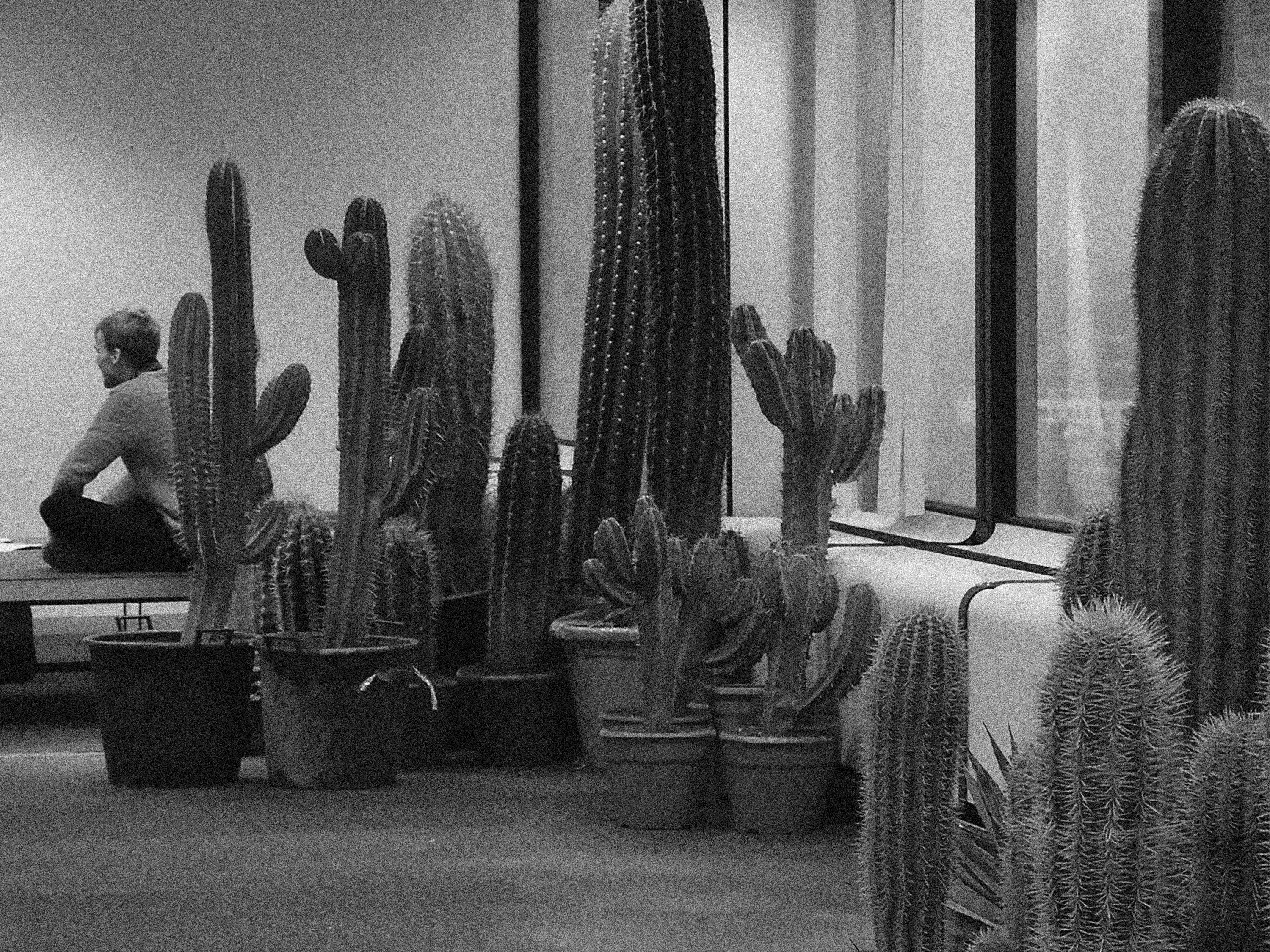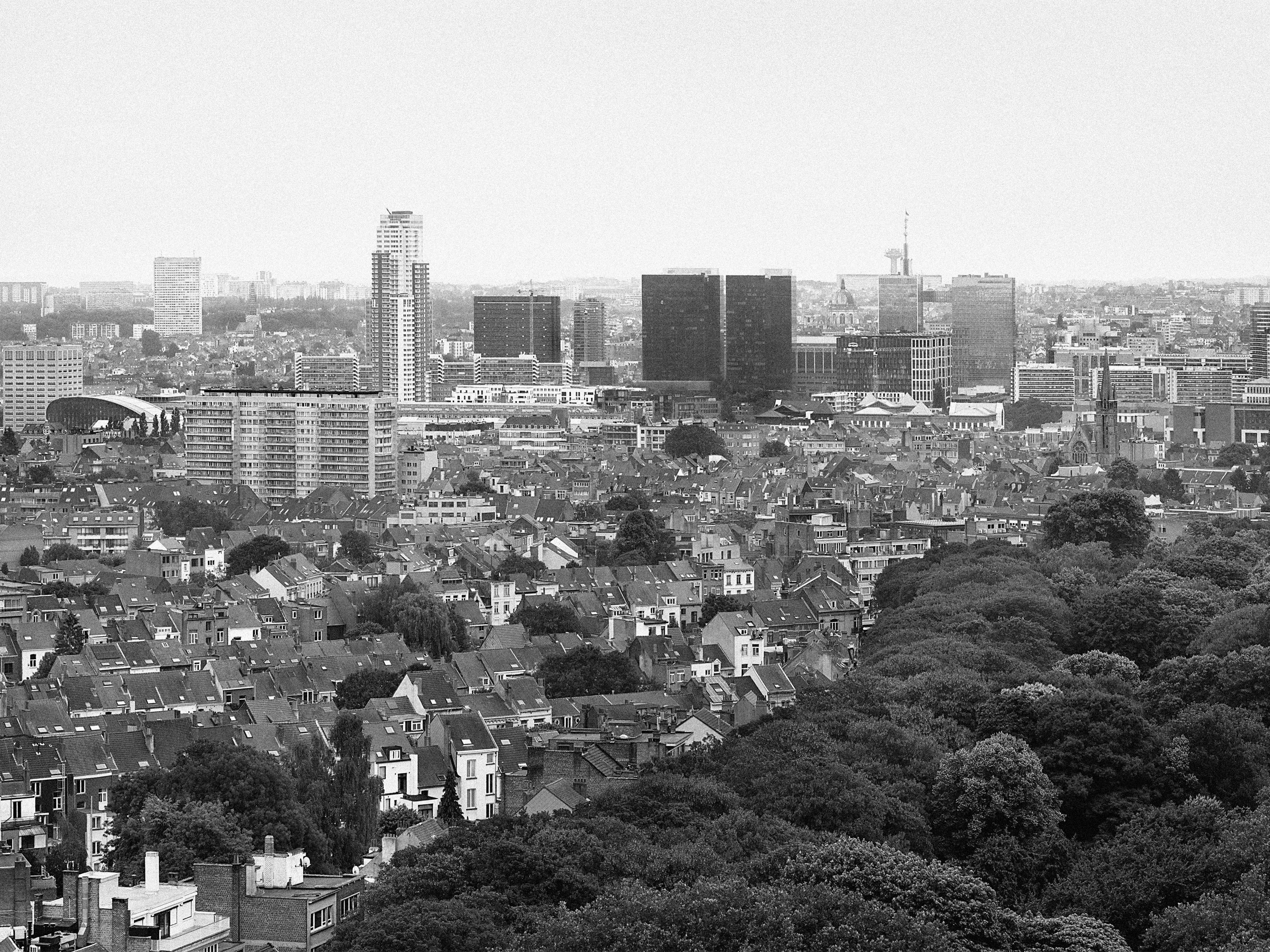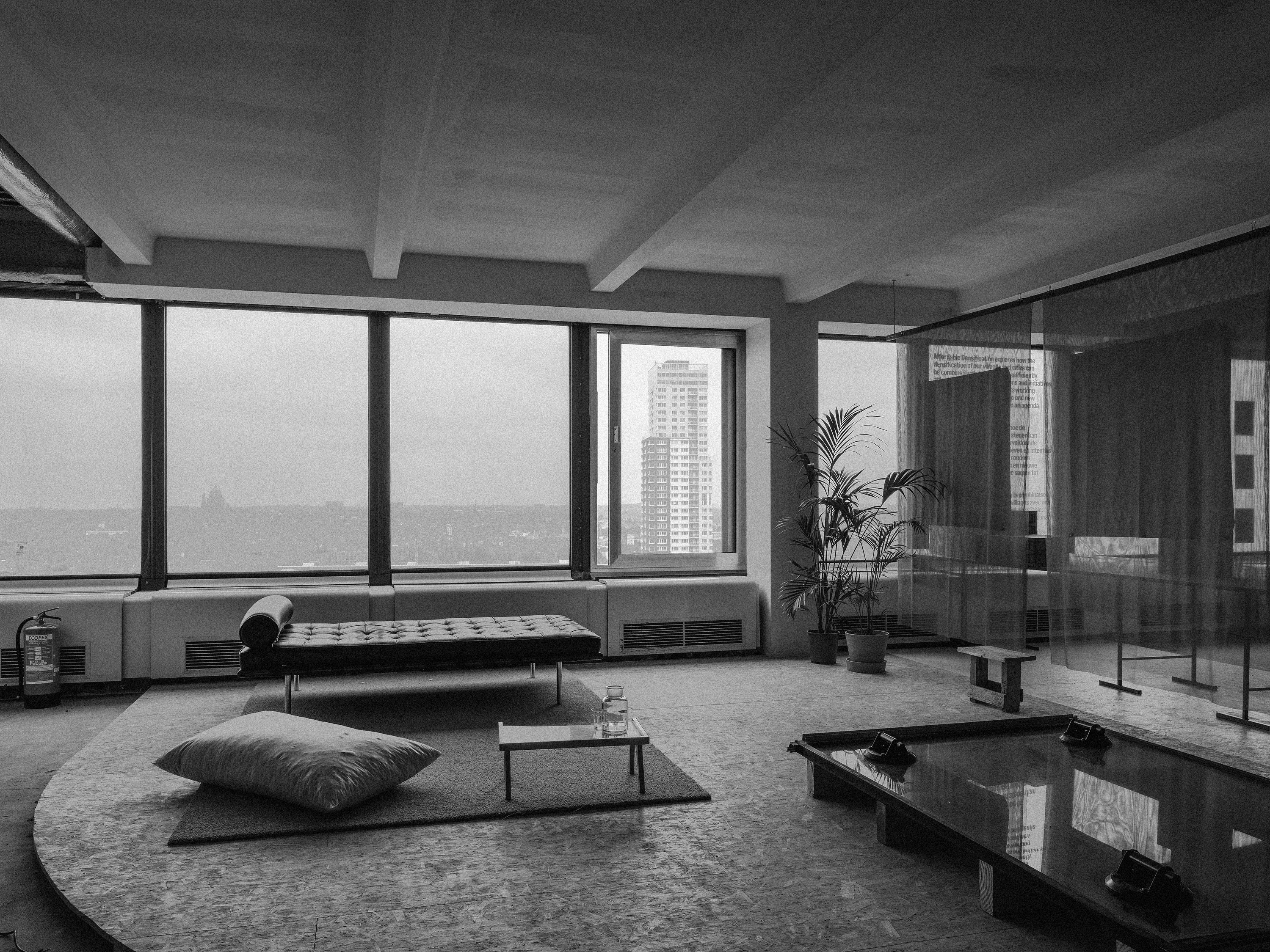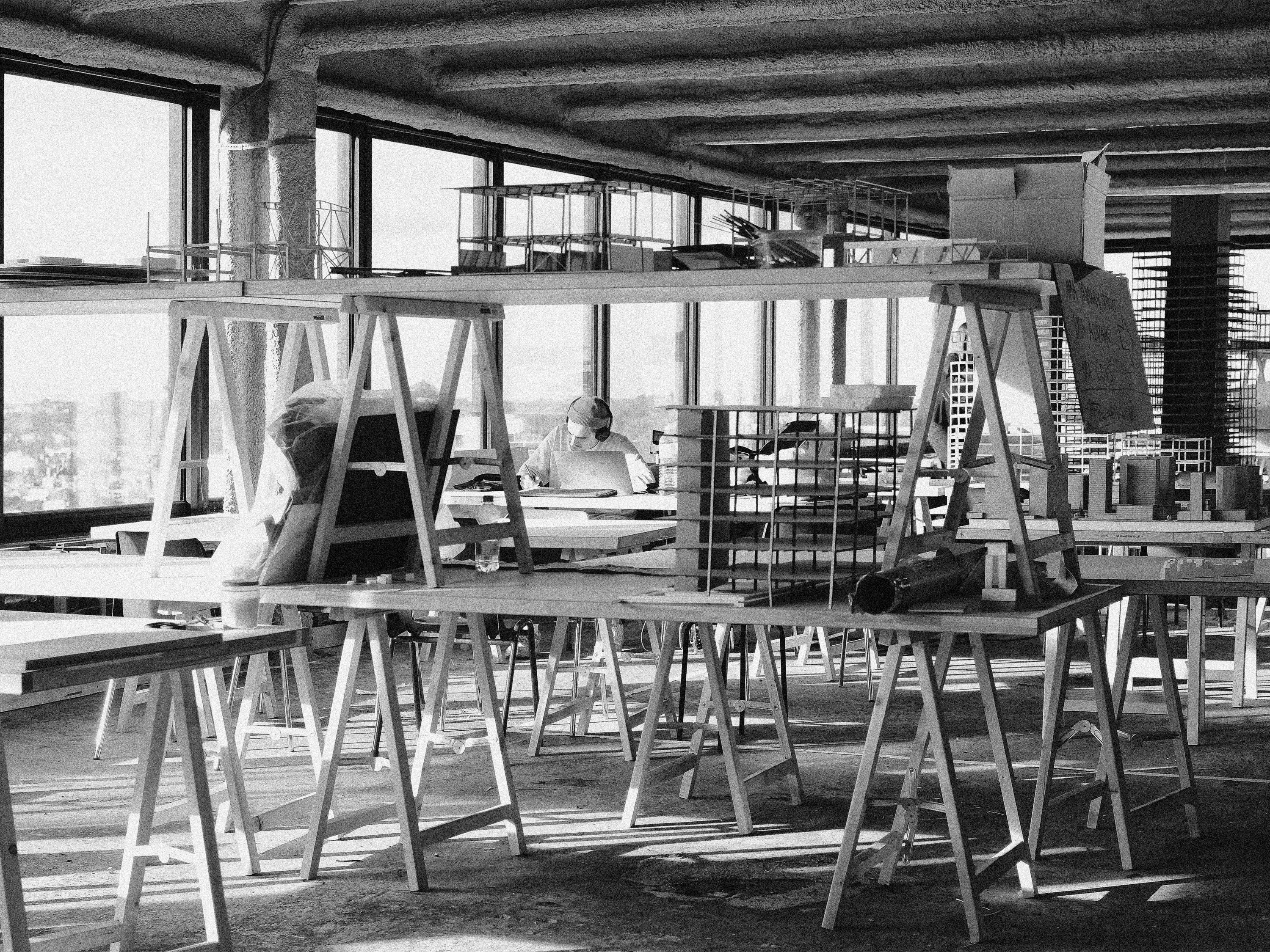An Interview at the WTC Brussels, 2019
Article



Architectural Practice and Education ‘From the Inside Out’ by Isabelle Doucet, interviewing Freek Persyn and Dieter Leyssen of 51N4E and Dag Boutsen of KU Leuven’s Faculty of Architecture. Originally published in Oase Issue number 102.
The towers of the former World Trade Center in Brussels, near Station Brussels-North, are the seats of experiments in teaching architecture. The WTC was once part of the so-called Manhattan Plan, a partially realised Central Business District from 1967. Because this ambitious project required the largescale demolition of a high-density residential area, it became a symbol of the destruction of the historical inner city and its social cohesion. 51N4E launched a fascinating initiative to heal this urban trauma. In 2017, the office reached an agreement with building owner Befimmo and the then brand-new organisation Up4North, a non-profit association that unites eight important local building owners. The building’s once sought-after spatial flexibility and open floor plans are in little demand in today’s corporate culture. But new, temporary users do appreciate these spaces: architecture offices, artists’ collectives, social organisations and Campus Sint-Lucas Brussels of the KU Leuven’s Faculty of Architecture. The building is now a test site for new forms of critical engagement ‘from the inside out’. It accommodates exciting collaborations and confrontations between architects, students, artists and building users and developers. Its interstitial position seems to suggest surprising connections among critical intellectuals, building promoters and creative entrepreneurs – actors whose interests usually conflict. This is an excellent opportunity to discuss the sociopolitical role of the architect.
Isabelle Doucet: I think there are two special sides to this project: that of different actors and practices coming together – those who temporarily ‘occupy’ the tower and the owners and developers – and on the other hand it seems important to me to take the specific circumstances of this location into account.
Dag Boutsen: True, it’s a unique neighbourhood: it’s grown really gradually, by trial and error, in a slow-motion process that’s still ongoing. This hasn’t happened in other cities; elsewhere, the 1960s to 1980s were characterised by rapid developments. It’s a very mixed neighbourhood as well: there’s Brabantstraat, you have prostitution in the Aarschotstraat, there’s the station area and then there’s the area around the WTC. The neighbourhood combines extremely different spheres and this somehow continues to touch, fascinate, bore or repel people.
Freek Persyn: I like that, that idea of slow-motion, of a lingering status quo. After all, it’s not a given that something will actually happen here at some point.
I.D. Urban activism in the 1970s in Brussels was mainly known for the campaigns of Noordwijk and ARAU. At the time, the destructive nature of spatial planning called an oppositional activism into being that was expressly against established planning and against the developers, both in Brussels and elsewhere. And yet, this kind of activism is often eventually, unintentionally, encapsulated, and in some cases even results in exactly the kind of architecture it originally opposed. It seems to me that the approach taken today, at the WTC, works ‘from the inside out’: the developer is tolerated as a stakeholder. But a critical practice ‘from the inside out’ does not come without its pitfalls. . . F.P. We don’t start from activist categories or historical references that we can use as frameworks, but take an open approach. What it is, exactly, that we do (or want to do) is not yet crystal clear. It’s difficult to place our approach in a historical narrative. We don’t actually start from the position we’re in, but from the position we’d like to be in. In this process, we can’t do much more than watch out for those pitfalls you mentioned.
I.D. But anticipating those pitfalls – such as manipulation, encapsulation, loss of critical distance. . . – is important? F.P. Yes, but it’s just as important to pay attention to the connections that arise among developers, investors and education. These connections can result in alliances that you wouldn’t expect from a historical or practical point of view.
I.D. Suppose activist architects started to examine ways to work with developers in all sincerity, would that create opportunities to do things that are impossible as long as parties diametrically oppose each other? For example, would the specific situation of this building (with its open floor plan, vacancy and visible construction) combined with investment challenges then lead to a situation in which an investor finances structural engineering experiments that give architects and students the opportunity to experiment ambitiously in an existing building – on a 1:1 scale? Dieter Leyssen Our office, 51N4E, is involved in the redevelopment of the building. We’re looking for ways to deal with the strict regulations for offices and to achieve maximum reuse. We developed a mockup on the twenty-third floor, for example, to test which floor and ceiling structures with minimum depths allow the reuse of the existing structure. Another experiment concerns windows, one of which was installed at the exhibition ‘You Are Here’, part of the International Architecture Biennale Rotterdam 2018. Right now, none of the windows in the tower open. As a test, we replaced a fixed window with a window that slides open over the maximum width allowed in a tower building.
D.B. This building is in a state of disassembly and that makes it an interesting educational tool. The message that a building consists of components and materials you can reuse afterwards really hits home here. And that’s an important lesson for students to learn.
I.D. In my opinion, it’s crucial. Because it means that socially committed students learn how the social role of architects can manifest: not only through participatory processes and social contributions, but also by working with materials or construction methods.
D.L. In your analysis of the actors who have come together here – the students, the activists, the professors and teachers – one actor is very important and specific to this location: capital. I am thinking of the investors who come here, or the architects of Jaspers-Eyers. They are the kind of architects and entrepreneurs who usually don’t visit such temporary places. Their influence on the students is not to be underestimated: they feel they’re part of a coalition that is forming around Noordwijk, consisting of different players than 40 years ago, but definitely with an agenda. I think that the design studios and the work exhibition ‘You Are Here’ are trying to influence and shape the agenda of that new coalition. I spoke here yesterday during a master class for real estate experts. People talked about the ‘impact coalition’ for Noordwijk, a new ‘growth coalition’ like that of the 1960s, with politicians, developers and investors. Compared with the 1960s, this coalition seems to have expanded – to include students, architects and artists. The question remains: Whose agenda is being prepared? The past year, we took the time to think about that agenda.
F.P. The use is temporary, but we want the studios, the debates and the publications to create a long-term perspective as well. I think the combination of immediacy and long-term reflection is important. Shigeru Ban presents very good examples of the importance of such preparatory work. He works in situations that are precarious, with an organisation that is not, so he suddenly has to deal with budgets, time horizons and preparation processes. You can’t come up with good interventions if you have to improvise all the time. I believe in taking the connections between precariousness and trauma on the one hand and organisation, good preparation and strategic thinking on the other seriously.
I.D. I think that’s especially the case in education, where you’re still free to improvise, less embedded in practical limitations. The ‘critical intellectual’ has a long tradition in architecture, characterised by the tension between the urge of (future) architects to work outside school walls and conventional practices and their need to still enjoy the necessary freedom, inside school walls, to think creatively and innovatively.
F.P. Moreover, a school is much more than students alone, although they are of course very important. As a student you operate in a different complexity than the teacher and the people who run the school and you also have different freedoms and responsibilities. Here, at the WTC, a school has come to an office district. The office district is changing and the school is changing. How are they changing together? These are interesting questions for a school to respond to and reflect on, regardless of the innocence of the students.
D.B. A school always has to remain a school: an island. This place is actually an incredible island as well, sitting here on the 24th floor, embedded in a concrete spatial, social and political situation as well as in a protected environment in which people can dream or fail. These are two extremely important characteristics of education that set it apart from the harsh, real world. Some schools forget this, by the way, and incorporate a huge amount of efficiency in their curriculum, curbing both the failing and the dreaming. I don’t think that we would ever go down that road; it’s not in the genes of KU Leuven’s Faculty of Architecture and the Campus Sint-Lucas Brussels.
I.D. I love the way you say that: the island is important, together with the freedom and autonomy that go with it. At the same time, you want to train architects to become critical and socially aware. How can we make that island for dreaming, failing and experimenting relevant to the outside world?
D.B. Let’s not forget that this is one of the reasons why architects are so keen on teaching: because it allows them to escape reality and absorb fun influences. And so education – indirectly – funds a practice that is underfunded by the harsh, real world!
D.L. This island is also the place where policymakers, developers and investors find inspiration. During the first master class at the University of Hasselt on the 19th floor here, the meetings between different people were very productive. If that value does not flow back into education, you have a discrepancy.
I.D. Another discrepancy arises when architectural education itself is never discussed. If students are encouraged to participate in all kinds of extracurricular projects, to work in the real world out there, to put more emphasis on processes than on products, but at the end of the day have to make a conventional design for a building to graduate, then you’re contradicting your own education, aren’t you? For example, I would love it if students would actually get to study how development and investment work, and how you can intervene in those processes, whether affirmative or disruptive.
F.P. In my opinion, the discussion is also about new roles. When you see a lot of young people that are really interested in becoming civil servants, this also shows an interest in the public interest, right? It’s good to think of new roles and role patterns. And in this context we have, in my opinion, been able to do this much more explicitly. Here, students do not foreshadow what they will become later, but they’re actually already full-fledged today, during the discussions with other parties, for example.
D.B. For the first time, it’s now suddenly possible to criticise established architects.
F.P. That makes it super interesting to us. We work together with Jaspers-Eyers Architects. On entering the lift, those architects come across a poster made by the students: ‘Welcome to Jaspers Town’. The sudden rubbing against each other of those different islands does have an impact. Sometimes the Jaspers-Eyers people come here to work constructively and at those times, you can feel the friction. At the very least, there is a perception that things are changing. The next question is the one Dieter raised a moment ago: What should we do at that time, what requirements should we put on the table? We have something to offer and they have something to offer, but what is it we actually want?
D.L. What’s important, therefore, is the ‘politics of presence’ that is temporarily activated here at the WTC. How long are you supposed to have those islands rub against each other before something transfers?
F.P. Don’t forget that what we’re dealing with here is an investor that is listed on the stock exchange and that has to meet benchmarks to find funds, Corporate Social Responsibility (CSR) being one of them. In order to achieve something in this area, they’ve also begun to think about ways to link social situations to global ideas about sustainability. What I mean to say is that these investments, however small they may be in comparison with what they may earn from them, are motivated by institutional mechanisms. For them, too, this is an experiment that destabilises their usual practice. At the outset, we concluded a service agreement: we can stay and work here without paying rent and in return we will provide a number of services, for example, finding users for the other floors together with Up4North, with 5,000 m2 now in use. Architecture Workroom Brussels is also housed in this tower under the terms of a service agreement: they organise ‘You Are Here’ in return. So that was the first step: creating a situation in which different activities and groups come together in the hope that meaningful things come to the surface. As yet, these meanings are not discussed often enough to understand their value. The Faculty of Architecture could also draw up a service agreement for this: to organise this discussion and make it public.
I.D. Perhaps this is a good time, to conclude, to leave policy and organisational aspects and return to the specificity of this place. What is different about the WTC? What does it contribute to architectural production?
D.L. For my research at the London School of Economics I interviewed architecture students who work here in the tower. They told us that what influenced them above all was the contrast between having a view from a tower for a long time – something that they otherwise only experienced temporarily, in a hotel for example – on the one hand, and entering on the ground floor on the other – so to go up from Station Brussels- North. Those two daily experiences really influenced the way they designed buildings.
I.D. The downstairs space is also exciting. You first have to walk through a typical corporate lobby, and then, when you step out of the lift, you actually find yourself in a squat. That certainly creates a very special atmosphere.
D.B. And in the evening, in winter, there’s no heating because it’s an office building. Under the direction of Corneel Cannaerts and Michiel Helbig, students have created projects in response to this, for example around circular economy, or in which a cynical view is developed. I think that’s great!
F.P. We have tested what a hybrid workplace can be, one including education, spaces for small and large offices and a work space that centres on transformation on the 23rd floor, with parties from every corner of society: private investors, sociocultural organisations, services, and all this in a place that open to the public, thanks to the roof terrace, among other things. The experiment shows that it is stimulating to have an environment that’s characterised by complexity and critical mass, in which you can gain different experiences and step into different roles. To achieve transformations, you must be able to make connections and look from various perspectives. In a place like this, that’s possible.
Translation: InOtherWords, Maria van Tol Thanks to: Lieven De Cauter and Gideon Boie for reading the text.